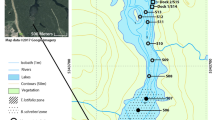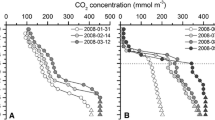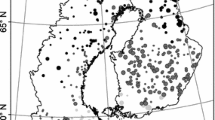Abstract
Extensive floodplains and numerous lakes in the Amazon basin are well suited to examine the role of floodable lands within the context of the sources and processing of carbon within inland waters. We measured diel, seasonal and inter-annual variations of CO2 concentrations and related environmental variables in open water and flooded vegetation and estimated their habitat area using remote sensing in a representative Amazon floodplain lake, Lake Janauacá. Variability in CO2 concentrations in open water resulted from changes in the extent of inundation and exchange with vegetated habitats. Depth-averaged values of CO2 in the open water of the lake, 157 ± 91 µM (mean ± SD), were less than those in an embayment near aquatic vegetation, 285 ± 116 µM, and were variable over 24-h periods at both sites. Within floating herbaceous plant mats, the mean concentration was 275 ± 77 µM, while in flooded forests it was 217 ± 78 µM. The best statistical model that included CO2 in aquatic plant mats, water clarity, rate of change in water level and chlorophyll-a concentrations explained around 90% of the variability in CO2 concentration. Three-dimensional hydrodynamic modeling demonstrated that diel differences in water temperature between plant mats and open water as well as basin-scale motions caused lateral exchanges of CO2 between vegetated habitats and open water. Our findings extend understanding of CO2 in tropical lakes and floodplains with measurements and models that emphasize the importance of flooded forests and aquatic herbaceous plants fringing floodplain lakes as sources of CO2 to open waters.








Similar content being viewed by others
References
Abril G, Borges AV. 2019. Ideas and perspectives: Carbon leaks from flooded land: do we need to replumb the inland water active pipe? Biogeosciences 16:769–784.
Abril G, Martinez J-M, Artigas LF, Moreira-Turcq P, Benedetti MF, Vidal L, Meziane T, Kim J-H, Bernardes MC, Savoye N, Deborde J, Souza EL, Albéric P, Landim de Souza MF, Roland F. 2014. Amazon River carbon dioxide outgassing fuelled by wetlands. Nature 505:395–398.
Almeida RM, Shi Q, Gomes-Selman JM, Angarita H, Barros N, Forsberg BR, García-Villacorta R, Hamilton SK, Melack JM, Montoya M, Perez G, Sethi SA, Gomes CP, Flecker AS. 2019. Reducing the greenhouse gas footprint of Amazon hydropower with optimal dam planning. Nature Communications 10:4281. https://doi.org/10.1038/s41467-019-12179-5.
Amaral JHF, Borges AV, Melack JM, Sarmento H, Barbosa PM, Kasper D, de Melo ML, De Fex-Wolf D, da Silva JS, Forsberg BR. 2018. Influence of plankton metabolism and mixing depth on CO2 dynamics in an Amazon floodplain lake. Science of the Total Environment 630:1381–1393.
Amaral JHF, Farjalla VF, Melack JM, Kasper D, Scofield V, Barbosa PM, Forsberg BR. 2019. Seasonal and spatial variability of CO2 in aquatic environments of the central lowland Amazon basin. Biogeochemistry 143:133–149.
Amaral JHF, Melack JM, Barbosa PM, MacIntyre S, Kasper D, Cortés A, Silva TSF, Nunes de Sousa R, Forsberg BR. 2020. Carbon dioxide fluxes to the atmosphere from waters within flooded forests in the Amazon basin. Journal of Geophysical Research: Biogeosciences 125:e02019JG005293. https://doi.org/10.1029/2019JG005293.
Anderson, DR. 2008. Model based inference in the life sciences: a primer on evidence. Springer Science & Business Media
Augusto-Silva PB, MacIntyre S, de Moraes Rudorff C, Cortés A, Melack JM. 2019. Stratification and mixing in large floodplain lakes along the lower Amazon River. Journal of Great Lakes Research 45:61–72.
Barbosa CCF, de Moraes Novo EML, Melack JM, Gastil-Buhl M, Filho WP. 2010. Geospatial analysis of spatiotemporal patterns of pH, total suspended sediment and chlorophyll-a on the Amazon floodplain. Limnology 11:155–166.
Barbosa PM, Amaral JHF, Melack JM, Farjalla VF, da Silva JS, Forsberg BR. 2018. High rates of methane oxidation in an Amazon floodplain lake. Biogeochemistry 137:351–365.
Barbosa PM, Melack JM, Amaral JHF, MacIntyre S, Kasper D, Cortés A, Farjalla VF, Forsberg BR. 2020. Dissolved methane concentrations and fluxes to the atmosphere from a tropical floodplain lake. Biogeochemistry 148:129–151.
Barton K, Barton MK. 2018. Package ‘MuMIn.’ Version 1:18.
Bonnet M-P, Pinel S, Garnier J, Bois J, Resende Boaventura G, Seyler P, Motta Marques D. 2017. Amazonian floodplain water balance based on modelling and analyses of hydrologic and electrical conductivity data. Hydrological Processes 31:1702–1718.
Coates MJ, Ferris J. 1994. The radiatively driven natural convection beneath a floating plant layer. Limnology and Oceanography 39:1186–1194.
Cole JJ, Prairie YT, Caraco NF, McDowell WH, Tranvik LJ, Striegl RG, Duarte CM, Kortelainen P, Downing JA, Middelburg JJ, Melack JM. 2007. Plumbing the global carbon cycle: Integrating inland waters into the terrestrial carbon budget. Ecosystems 10:172–185.
Devol AH, Zaret TM, Forsberg BR. 1984. Sedimentary organic matter diagenesis and its relation to the carbon budget of tropical Amazon floodplain lakes. Verhandlungen Internationale Vereinigen Limnologie 22:1299–1304.
Doyle, RD. 1991. Primary production and nitrogen cycling within the periphyton community associated with emergent aquatic macrophytes in an Amazon floodplain lake. Ph.D. Thesis. University of Maryland. 269 p.
Drake TW, Raymond PA, Spencer RGM. 2018. Terrestrial carbon inputs to inland waters: A current synthesis of estimates and uncertainty: Terrestrial carbon inputs to inland waters. Limnology and Oceanography 3:132–142.
Engle DL, Melack JM. 1989. Floating meadow epiphyton: biological and chemical features of epiphytic material in an Amazon floodplain lake. Freshwater Biology 22:479–494.
Engle DL, Melack JM. 1993. Consequences of riverine flooding for seston and the periphyton of floating meadows in an Amazon floodplain lake. Limnology and Oceanography 38:1500–1520.
Engle DL, Melack JM, Doyle RD, Fisher TR. 2008. High rates of net primary production and turnover of floating grasses on the Amazon floodplain: implications for aquatic respiration and regional CO2 flux. Global Change Biology 14:369–381.
Forsberg BR, Melack JM, Richey JE, Pimentel TP. 2017a. Regional and seasonal variability in planktonic photosynthesis and planktonic community respiration in Amazon floodplain lakes. Hydrobiologia 800:187–206.
Forsberg BR, Dunne T, Melack JM, Venticinque E, Goulding EM, Barthem R, Paiva RCD, Sorribas MV, da Silva-Júnior UL, Weisser S. 2017b. Potential impact of new Andean dams on the Amazon fluvial ecosystems. PLoS One 12(8):e0182254.
Frankignoulle M, Borges A, Biondo R. 2001. A new design of equilibrator to monitor carbon dioxide in highly dynamic and turbid environments. Water Research 35:1344–1347.
Furch K, Junk WJ. 1997. The chemical composition, food value and decomposition of herbaceous plants, leaves, and leaf litter of the flooded forests. In: Junk WJ, Ed. Central Amazon floodplain. Ecological Studies, . Berlin: Springer. pp 187–206.
Gelman A, Su Y-S. 2018. arm: data analysis using regression and multilevel/hierarchical models. R package version 1.10-1. https://CRAN.R-project.org/package=arm.
Grueber CE, Nakagawa S, Laws RJ, Jamieson IG. 2011. Multimodel inference in ecology and evolution: challenges and solutions: Multimodel inference. Journal of Evolutionary Biology 24:699–711.
Gruner DS, Bracken MES, Berger SA, Eriksson BK, Gamfeldt L, Matthiessen B, Moorthi S, Sommer U, Hillebrand H. 2017. Effects of experimental warming on biodiversity depend on ecosystem type and local species composition. Oikos 126:8–17.
Hansen AM, Kraus TEC, Pellerin BA, Fleck JA, Downing BD, Bergamaschi BA. 2016. Optical properties of dissolved organic matter (DOM): Effects of biological and photolytic degradation. Limnology and Oceanography 61:1015–1032.
Helms JR, Stubbins A, Ritchie JD, Minor EC, Kieber DJ, Mopper K. 2008. Absorption spectral slopes and slope ratios as indicators of molecular weight, source, and photobleaching of chromophoric dissolved organic matter. Limnology and Oceanography 53:955–969.
Hess LL, Melack JM, Affonso AG, Barbosa C, Gastil-Buhl M, Novo EMLM. 2015. Wetlands of the lowland Amazon basin: extent, vegetative cover, and dual-season inundated area as mapped with JERS-1 synthetic aperture radar. Wetlands 35:745–756.
Hodges, BR. 2000. Numerical Techniques in CWR-ELCOM (code release v.1). Nedlands, Australia: The University of Western Australia, Center for Water Research. 37p.
Hodges BR, Dallimore C. 2019. Aquatic ecosystem model: AEM3D, user manual. Docklands, Australia: Hydronumerics.
Hodges BR, Imberger J, Saggio A, Winters KB. 2000. Modeling basin-scale internal waves in a stratified lake. Limnology and Oceanography 45:1603–1620.
Jiménez-Muñoz JC, Mattar C, Barichivich J, Santamaría-Artigas A, Takahashi K, Malhi Y, Sobrino JA, van der Schrier G. 2016. Record-breaking warming and extreme drought in the Amazon rainforest during the course of El Niño 2015–2016. Scientific Report 6:33130.
Johnson MS, Lehmann J, Riha SJ, Krusche AV, Richey JE, Ometto JPHB, Couto EG. 2008. CO2 efflux from Amazonian headwater streams represents a significant fate for deep soil respiration. Geophysical Research Letters 35:L17401.
Junk WJ, Bayley PB, Sparks RE. 1989. The flood pulse concept in river-floodplain systems. Canadian Special Publication of Fisheries and Aquatic Sciences 106:110–127.
Junk WJ, Piedade MTF. 1993. Biomass and primary-production of herbaceous plant communities in the Amazon floodplain. Hydrobiologia 263:155–162.
Junk WJ, Piedade MTF, Wittmann F, Schöngart J, Parolin P, Eds. 2010. Amazonian floodplain forests: ecophysiology, biodiversity and sustainable management. Dordrecht (Netherlands), New York: Springer.
Kayler ZE, Premke K, Gessler A, Gessner MO, Griebler C, Hilt S, Klemedtsson L, Kuzyakov Y, Reichstein M, Siemens J, Totsche K-U, Tranvik L, Wagner A, Weitere M, Grossart H-P. 2019. Integrating aquatic and terrestrial perspectives to improve insights into organic matter cycling at the landscape scale. Frontiers in Earth Science 7:127.
Lapierre JF, del Giorgio PA. 2012. Geographical and environmental drivers of regional differences in the lake pCO2 versus DOC relationship across northern landscapes. Journal of Geophysical Research: Biogeosciences 117:1–10.
Lauerwald R, Regnier P, Camino-Serrano M, Guenet B, Guimberteau M, Ducharne A, Polcher J, Ciais P. 2017. ORCHILEAK (revision 3875): a new model branch to simulate carbon transfers along the terrestrial-aquatic continuum of the Amazon basin. Geoscientific Model Development 10:3821–3859.
Lukacs PM, Burnham KP, Anderson DR. 2010. Model selection bias and Freedman’s paradox. Annals of the Institute of Statistical Mathematics 62:117–125.
MacIntyre S, Melack JM. 1995. Vertical and horizontal transport in lakes: linking littoral, benthic, and pelagic habitats. Journal of the North American Benthological Society 14:599–615.
MacIntyre S, Fernandes Amaral JH, Barbosa PM, Cortés A, Forsberg BR, Melack JM. 2019. Turbulence and gas transfer velocities in sheltered flooded forests of the Amazon Basin. Geophysical Research Letters 46:9628–9636.
Marotta H, Duarte CM, Sobek S, Enrich-Prast A. 2009. Large CO2 disequilibria in tropical lakes. Global Biogeochemical Cycles 23:GB4022.
McDonald CP, Stets EG, Striegl RG, Butman D. 2013. Inorganic carbon loading as a primary driver of dissolved carbon dioxide concentrations in the lakes and reservoirs of the contiguous United States. Global Biogeochemical Cycles 27:285–295.
Melack JM, Engle DL. 2009. An organic carbon budget for an Amazon floodplain lake. Verhandlungen Internationale Vereinigen Limnologie 30:1179–1182.
Melo ML, Bertilsson S, Amaral JHF, Barbosa PM, Forsberg BR, Sarmento H. 2019. Flood pulse regulation of bacterioplankton community composition in an Amazonian floodplain lake. Freshwater Biology 64:108–120.
Mortillaro JM, Passarelli C, Abril G, Hubas C, Alberic P, Artigas LF, Benedetti MF, Thiney N, Moreira-Turcq P, Perez MAP, Vidal LO, Meziane T. 2016. The fate of C4 and C3 macrophyte carbon in central Amazon floodplain waters: Insights from a batch experiment. Limnologica 59:90–98.
Mortimer CH. 1952. Water movements in lakes during summer stratification – Evidence from the distribution of temperature in Windermere. Philosophical Transactions of the Royal Society of London B 236:355–404.
Piedade MTF, Junk WJ, Long SP. 1991. The productivity of the C4 grass Echinochloa Polystachya on the Amazon floodplain. Ecology 72:1456–1463.
Piedade MTF, Junk W, D’Ângelo SA, Wittmann F, Schöngart J, Barbosa KM do N, Lopes A. 2010. Aquatic herbaceous plants of the Amazon floodplains: state of the art and research needed. Acta Limnologica Brasiliensia 22:165–178.
Pinel S, Bonnet M-P, Da Silva JS, Sampaio TC, Garnier J, Catry T, Calmant S, Fragoso CR Jr, Moreira D, Marques DM, Seyler F. 2020. Flooding dynamics within an Amazonian floodplain: Water circulation patterns and inundation duration. Water Resources Research 56:e2019WR026081.
Premke K, Attermeyer K, Augustin J, Cabezas A, Casper P, Deumlich D, Gelbrecht J, Gerke HH, Gessler A, Grossart H-P, Hilt S, Hupfer M, Kalettka T, Kayler Z, Lischeid G, Sommer M, Zak D. 2016. The importance of landscape diversity for carbon fluxes at the landscape level: small-scale heterogeneity matters. Wires Water 3:601–617.
Quay PD, Wilbur D, Richey JE, Hedges JI, Devol AH, Victoria R. 1992. Carbon cycling in the Amazon River: Implications from the 13C compositions of particles and solutes. Limnology and Oceanography 37:857–871.
R Core Team. 2020. R: A language and environment for statistical computing. R Foundation for Statistical Computing, Vienna, Austria. URL https://www.R-project.org/.
Richey JE, Devol AH, Wofsy SC, Victoria R, Riberio MNG. 1988. Biogenic gases and the oxidation and reduction of carbon in Amazon River and floodplain waters: Amazon dissolved gases. Limnology and Oceanography 33:551–561.
Richey JE, Melack JM, Aufdenkampe AK, Ballester VM, Hess LL. 2002. Outgassing from Amazonian rivers and wetlands as a large tropical source of atmospheric CO2. Nature 416:617–620.
Rudorff CM, Melack JM, MacIntyre S, Barbosa CCF, Novo EMLM. 2011. Seasonal and spatial variability of CO2 emission from a large floodplain lake in the lower Amazon. Journal of Geophysical Research 116:G04007.
Silva MP, Sander de Carvalho LA, Novo E, Jorge DSF, Barbosa CCF. 2020. Use of optical absorption indices to assess seasonal variability of dissolved organic matter in Amazon floodplain lakes. Biogeosciences 17:5355–5364.
Sippel S, Hamilton S, Melack J. 1992. Inundation area and morphometry of lakes on the Amazon River floodplain, Brazil. Archiv Für Hydrobiologie 123:385–400.
Smith LK, Melack JM, Hammond DE. 2003. Carbon, nitrogen and phosphorus content and 210Pb-derived burial rates in sediments of an Amazon floodplain lake. Amazoniana 17:413–436.
Smith-Morrill, L. 1987. The exchange of carbon, nitrogen, and phosphorus between the sediments and water-column of an Amazon floodplain lake. Ph.D. Thesis. University of Maryland. 209 p.
Sobek S, Tranvik LJ, Cole JJ. 2005. Temperature independence of carbon dioxide supersaturation in global lakes. Global Biogeochemical Cycles 19:1–10.
Sorribas MV, Paiva RCD, Melack J, Jones C, Carvalho L, Bravo JM, Beighley E, Forsberg B, Costa MH. 2016. Projections of climate change effects on discharge and inundation in the Amazon River basin. Climatic Change 136:555–570.
Tranvik LJ, Downing JA, Cotner JB, Loiselle SA, Striegl RG, Ballatore TJ, Dillon P, Finlay K, Fortino K, Knoll LB, Kortelainen PL, Kutser T, Soren Larsen, Laurion I, Leech DM, McCallister SL, McKnight DM, Melack JM, Overholt E, Porter JA, Prairie Y, Renwick WH, Roland F, Sherman BS, Schindler DW, Sobek S, Tremblay A, Vanni MJ, Verschoor AM, von Wachenfeldt E, Weyhenmeyer GA. 2009. Lakes and reservoirs as regulators of carbon cycling and climate. Limnology and Oceanography 54:2298–2314.
Waichman AV. 1996. Autotrophic carbon sources for heterotrophic bacterioplankton in a floodplain lake of central Amazon. Hydrobiologia 341:27–36.
Ward ND, Keil RG, Medeiros PM, Brito DC, Cunha AC, Dittmar T, Yager PL, Krusche AV, Richey JE. 2013. Degradation of terrestrially derived macromolecules in the Amazon River. Nature Geoscience 6:530–533.
Weishaar JL, Aiken GR, Bergamaschi BA, Fram MS, Fujii R, Mopper K. 2003. Evaluation of specific ultraviolet absorbance as an indicator of the chemical composition and reactivity of dissolved organic carbon. Environmental Science & Technology 37:4702–4708.
Woodward BL, Marti CL, Imberger J, Hipsey MR, Oldham CE. 2017. Wind and buoyancy driven horizontal exchange in shallow embayments of a tropical reservoir: Lake Argyle, Western Australia. Limnology and Oceanography 62:1636–1657.
Acknowledgements
Field work was supported by Ministério da Ciência Tecnologia CNPq/LBA-Edital.68/2013, processo 458036/ 2013-8, and CNPq - Universal processo 482004 / 2012-6 to BRF, US Department of Energy Contract DE-0010620 to JMM, and CNPq/LBA Edital 68/2013, processo 458038/2013-0 to Thiago Silva. Post-graduate scholarships were provided to JHFA and PMB, by CNPQ and CAPES. JHFA is thankful to the Université de Liège for a research grant (SRDE) and CAPES for the grant Programa de Doutorado Sanduíche no Exterior -88881.135203/2016-01. JMM received support from NASA (Contract NNX14AD29G), the US Department of Energy (Contract DE-0010620) and a Fulbright fellowship for field studies. Additional support for data analysis was provided by NASA (Contracts NNX14AD29G and NNX17AK49G) and the US National Science Foundation (Division of Environmental Biology, Grant Number 1753856) to JMM and SM. AVB is a research director at the Fonds National de la Recherche Scientifique (FNRS). The authors thank INPA for logistical support, João B. Rocha for the field support, Michaela L. Melo, Daniela D. F. Wolf, Maiby Glorize, Elizandra Sampaio and Jonismar S. Souza for laboratory and field support, Lúcia Silva for offering her floating house as a research base, Rodrigo Nunes and Thiago Silva for providing information and discussions related to aquatic plants, and Fernanda Ribeiro for sharing the code for the landcover classification of high-resolution images and discussions related to the remote sensing.
Author information
Authors and Affiliations
Corresponding author
Ethics declarations
Conflict of interest
The authors declare that they have no conflict of interest.
Supplementary Information
Below is the link to the electronic supplementary material.
Supplementary file2 (MP4 3138 KB)
Rights and permissions
About this article
Cite this article
Amaral, J.H.F., Melack, J.M., Barbosa, P.M. et al. Inundation, Hydrodynamics and Vegetation Influence Carbon Dioxide Concentrations in Amazon Floodplain Lakes. Ecosystems 25, 911–930 (2022). https://doi.org/10.1007/s10021-021-00692-y
Received:
Accepted:
Published:
Issue Date:
DOI: https://doi.org/10.1007/s10021-021-00692-y




